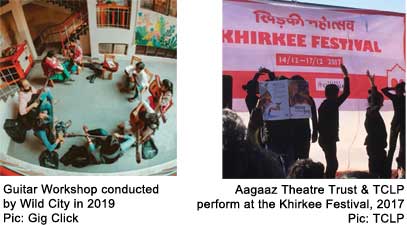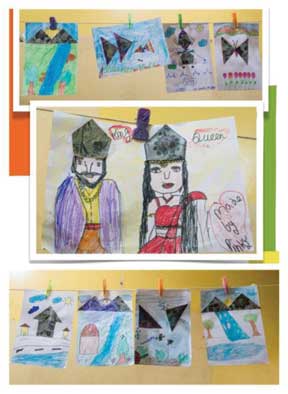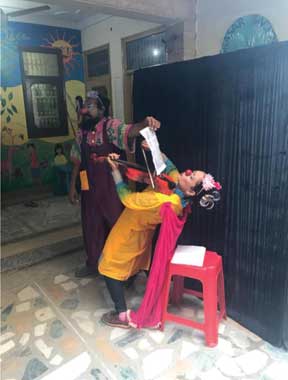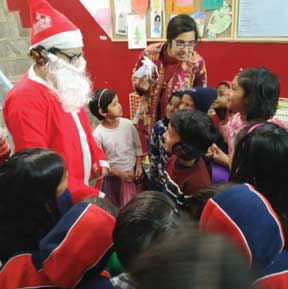Purnima Rao
Art, language, pleasure and beauty. Much as they’re extolled as universal liberators of the soul, India’s realities shatter any such notion. Art is not free, beauty and language are often enslaved by elite lobbies and pleasure Only those who can afford it are deemed worthy. When creative enjoyment and expression are handcuffed by historic oppression, what is the role of a free library that opens its doors to all?
When Delhi-based TCLP-The Community Library Project first started art and craft sessions in 2015, the program was an instant hit. The number one question as children walked in was: “Ma’am kya aaj art class hogi?” (Ma’am is there an art class today?) ‘Art class’ was whatever our volunteer of the hour could rustle up. Some days it was craft sessions elaborately prepped from materials like matchboxes, stickers or colourful construction paper. On more chaotic days, it was as basic as paper and crayons. For an hour and a half, children would hunch over their projects in intense meditation. Crayons would be requested and waited for, then passed from hand to hand, like songs of solidarity. Sometimes groups would form, tiny circles of little boys and girls all drawing the same thing: a landscape with snow-capped mountains, the sun rising (or setting, artist’s choice). A babbling brook flowing from between the peaks reaching the bottom of the sheet. A single, solitary house with slanted roof. Sometimes a dog, cat or cow. Always V-shaped birds. The art-volunteer might ask “Why are you all drawing the same thing?” The artists would be surprised. Look closer: not everyone’s sun was orange. His was green, hers was purple and theirs was neon pink. No ma’am, they are not all the same.

At the free library, art is an invitation to see, hear, touch, feel and speak in ways that are suppressed elsewhere. A ‘free library artist’ may experience new acceptance, where mountain landscapes are celebrated for red snow. A ‘free library actor’ may be cast as hero because his heart burns brighter than his speech impediment. A feisty teenager may be a ‘free library cinematographer’ despite the demands of school and housework. She sees the world through a phone, not a professional camera, gifting us a new mis-en-scene. A ‘free library writer’ who understands both oppression and empowerment in his blood, will be read by thousands when his essay, rejected by so many for imperfect grammar, is finally published at the free library. Here, members own both stage and page. All are welcome to create, not just for narrow markets but for their own to enjoy.

Pic: TCLP
What makes this degree of artistic empowerment possible? It would be tempting to consider this a simple question of aesthetic liberation. That if we, as practitioners, merely freed our minds of the ‘good-art-bad-art’ binary, we could embrace all kinds of artists. But this is an incomplete understanding of the exclusion experienced by historically oppressed communities. Let’s take an example of a public-school going child of privilege, who has had access to regular art classes from an early age. The day she decides to draw outside the lines, she is reprimanded and shamed. The scars run deep, perhaps deep enough to discourage her from drawing again. Nevertheless, the institutional invitation for her to create is never withdrawn. Should she overcome her trauma or choose to seek out the experience again, it will be made easily available. Consider now the child without the similar socio-economic capital. She has no such invitation to the art class and must wait to be allowed in. If she is, her work will not have the markers of artistic training her more privileged peers received over the years. This will be ‘strike one’ against her. If she willfully decides to draw outside the lines, it will be seen as a further transgression; strikes two and three all rolled into one. The punishment for her will not just be shame or discouragement but outright banishment. Someone else, who proves their worth by colouring within the lines, will take her place, limited as these spots are for children like them.
The Community Library Project aims to provide freedom on both fronts: aesthetic and social. By design, the space is free and open to all, as are all the materials, supplies and knowledge resources within it. Practitioners work consciously to remove barriers by designing programs for its most vulnerable and under-served members. The onus is not on the member to contort herself to fit the art class. It is on the art educator to cater to her specific needs; to not just allow entry but to invite. The key word, then, isn’t freedom but trust. To trust the child, the artist, regardless of their caste and class location, gender identity, age or physical and mental ability is the deep work that all educators must do. When done effectively, trust changes the nature of the experience – not just of how art is created but how it is enjoyed.

Pic: TCLP
At TCLP, the ‘free library art gallery’ invites anyone off the streets to waft in at will. No one is surveilled and everyone can enjoy exhibits for as long as they like. There is the ‘free library theatre’ where tickets are as free as the popcorn. Money can’t buy the best seats but height might. Tiny ones in the front, taller ones in the back, seats for those who can’t stand and spots near the stage for those who can’t see or hear well. Literary evenings at TCLP are something else. Kavi sammelans showcase both local and world-renowned talents on the same stage, even compelling the more acclaimed poet to change his readings, last minute, from English haikus (always a hit at the India Habitat Center) to Punjabi poems. In this space, all aesthetic works are reviewed from the lens of the oppressed. All critiques are new and revolutionary.
This has only been possible because at TCLP, pedagogy and praxis is political. And nothing underscored this more than the 2020 COVID-19 crisis, which forced a shutdown of our arts and crafts program. Lost were the hallowed theatre stages, where our members’ lives were reflected back to them. There was no more film appreciation, intimate guitar circles or boisterous clownery. No one knew when we would celebrate Christmas at the library again or relive that jaw-dropping moment right after ‘Twas the Night Before Christmas’ when Santa appeared out of nowhere, bearing gifts for all. While children with privilege moved onto online platforms to pursue the arts, for TCLP’s artists, there was no such transition. But make no mistake. This is not about a virus.
If anything, the pandemic has exposed the direct link between our members’ losing their artistic freedoms and the social evils that have put Indian artists under attack for years. Artist M.F. Hussain was hounded until his death by religious fundamentalists. Since 2011, members of the anti-caste theatre collective ‘Kabir Kala Manch’ have been held under the draconian UAPA. Poet Varavara Rao, whose health declines every day, is similarly held a political prisoner. Artists are routinely punished for revealing both the beauty and ugliness of our world while the social elite decides who lives and who dies for their art. The same forces that target these artists are those that deny the children of TCLP their artistic entitlements. How many masterpieces have we lost like this? How many iconoclasts have been culled? How many more are we willing to lose before stage and page are reclaimed? Even as arts educators reflect on personal truths and aesthetic ideas, they must draw a straight line from grassroot work to real-world threats. The threat is not ‘out there’ but ever-present in our tiny community libraries and neighbourhood schools. There is no time to waste.

Pic: TCLP
Our young creators can’t afford to wait for others to change reality or cede space. They must find safe spaces now, to liberate their art and make new meaning. When they do, they will give us a dazzling new world, with new stories, songs and visions that transform. Worlds that those who tried to withhold it, always feared but never imagined.
Speaking To Flowers
– Kanchan, 14 years, TCLP member (translated from Hindi)
I listen to my mother, I listen.
I mind my brother, I hear.
I hear the car’s ‘pon-pon’ sound.
I mind my papa’s words.
I have listened to my sister.
I have heard the koel’s song,
I have heard the sound of pots and pans,
I have heard the sounds of birds.
This poem is part of a 2016 anthology, created as part of a month-long poetry workshop with Upper Group members of the The Community Library Project. Sessions were bilingual, in Hindi and English and drew heavily on Kenneth Koch’s Wishes, Lies, and Dreams: Teaching Children to Write Poetry.
– Kanchan is 19 years old today.
The author works at The Community Library Project in Delhi-NCR and is a facilitator for The Community Library Network-TCLN, which is a collective of 75+ free libraries and library practitioners across India. She is committed to working for and promoting the free library movement.
